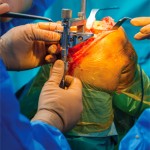Dr. Katz says any patient considering surgery should coordinate with their rheumatologist to find the best fit for a surgeon familiar with their rheumatic disease. It’s also important that the surgeon operates in a surgical facility in which a high volume of total joint surgeries are annually performed.
Medication management is an important care element for collaborative discussion, particularly if the patient is on an immunosuppressant that will need to be suspended prior to surgery and restarted after surgery at a point that won’t delay the healing of the operative sight. Dr. Katz says, “During medication therapy suspension, flare-ups may be more likely to occur and could compound the pain a patient experiences after surgery.”
Postoperative pain management medication should be closely planned, particularly because some frail patients with rheumatic diseases may not tolerate non-steroidal anti-inflammatory drugs. Opiates are typically prescribed after joint replacement surgery, according to Dr. Berry and Dr. Katz, but they stress that responsible management of opiates should be considered in relation to the patient’s pain.
In terms of expected outcomes, Dr. Katz is particularly interested in patients with osteoarthritis who also commonly undergo joint replacement and may achieve pain relief, but no improvement in physical activity. He says one question rheumatologists and surgeons are investigating is how to get these patients moving most effectively after surgery.
Physical Therapy Options
In addition to addressing long-term postoperative goals, Dr. Katz and Dr. Berry stress the importance for carefully orchestrated postoperative physical therapy immediately after surgery. They suggest this therapy should take into account unique challenges that a patient with a rheumatic disease may experience. Example: Having a patient use a walker or cane after surgery can put strain on inflamed and damaged wrist joints.
That’s why physical therapist Maura Daly Iversen, DPT, MPH, PT, SD, suggests the physical therapist meet with a surgical patient before surgery. Dr. Iversen is a professor and chair in the Department of Physical Therapy, Movement and Rehabilitation Sciences at Northeastern University in Boston.
“It’s important for patients to have clear expectations for what postoperative therapy will involve and work with their physical therapist ahead of time to establish a plan for specialized walkers or other assistive devices the patient can get used to using before surgery,” Dr. Iversen explains.
She is also a strong advocate for preoperative physical therapy to help patients recover faster after surgery, an approach supported by research she has conducted. In one study, exercise participation prior to total joint arthroplasty substantially reduced the risk of patients being discharged to a rehabilitation facility after surgery.3


